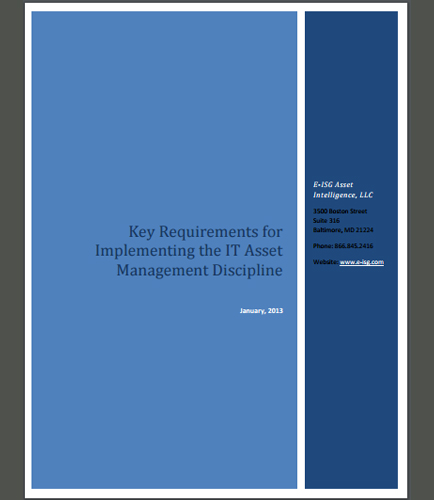
PROCESSING. PLEASE WAIT...


White Paper: E-ISG Asset Intelligence LLC
IT Asset Management: Why is it Necessary?
Implementing the IT Asset Management Discipline (ITAM) is a set of business practices that incorporates IT assets across the business units within the organization.
Without establishing IT asset management processes, organizations can’t effectively manage the diverse and mobile portfolio of IT assets.
IT Asset management is responsible in managing the overall life cycle including tactical and strategic decision making. All these challenges have required a holistic approach to IT asset management implementation and prioritize a couple of critical reasons such as:
Visibility to total cost of maintaining the IT infrastructure.
Visibility to the availability of resources.
This whitepaper discusses about the key requirements for implementing the IT asset management discipline and guides you in choosing the solutions and available tools to manage the IT assets.
What is the need of IT Asset Management discipline?
What is ITIL? What are the key benefits of IT Asset Management?
What are the common challenge of implementing a Software Asset Management program and how to overcome them?
What are the requirements for a disciplined approach to IT Asset Management?
What are the tools required to support the disciplined approach to IT Asset Management?
What are the tools required to support the disciplined approach to IT Asset Management?
By: Software AG
Digital business transformation is based on an IT architecture transformation with a roadmap for digital capability implementation. Based on the software platforms, digital companies create enhanced or totally new business models which offer completely new digital customer experiences. Established companies are building up software know-how and are acquiring software companies to accelerate their digital transformation by injecting software innovation capabilities into their core business areas. This whitepaper helps to understand what makes today’s digital challengers attractive to customers and consumers, as it highlights their core competencies and differentiators based on their digital software-based technology. Key takeaways from this whitepaper: Digital challengers separate companies from their customers Implementing digital capabilities for digital use cases Digital companies have a micro services-oriented, scalable IT architecture
By: Jedox
The most flexible Business Intelligence (BI) platform, QlikView, allows its users to gain valuable insights by understanding the fine line between the relevant data and the redundant data. It stimulates unrestricted analysis of application data, thus helping users make timely and accurate decisions. If you are already aware of the above mentioned BI platform, then here’s an investment solution that would add on to the values of your Qlik investment. This white paper reveals the concealed facet of the same BI tool that could be coherently integrated with an extension facilitating freedom and flexibility for everyone in the company, in terms of analyzing planning data. This QlikView white paper unfolds how you can enhance your Qlik system with data capture and write-back to the database as well as specific planning functionality such as easy top-down planning and driver-based bottom-up planning, unifying Business Intelligence (BI) with Corporate Performance Management (CPM).


 2025 All Rights Reserved | by: www.ciowhitepapersreview.com
2025 All Rights Reserved | by: www.ciowhitepapersreview.com